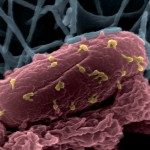Lien vers Pubmed [PMID] – 39296778
Lien DOI – 10.1093/ismeco/ycae105
ISME Commun 2024 Jan; 4(1): ycae105
Bacteriophages (phages) are increasingly considered for both treatment and early detection of bacterial pathogens given their specificity and rapid infection kinetics. Here, we exploit an engineered phage expressing nanoluciferase to detect signals associated with Pseudomonas aeruginosa lysis spanning single cells to populations. Using several P. aeruginosa strains we found that the latent period, burst size, fraction of infected cells, and efficiency of plating inferred from fluorescent light intensity signals were consistent with inferences from conventional population assays. Notably, imaging-based traits were obtained in minutes to hours in contrast to the use of overnight plaques, which opens the possibility to study infection dynamics in spatial and/or temporal contexts where plaque development is infeasible. These findings support the use of engineered phages to study infection kinetics of virus-cell interactions in complex environments and potentially accelerate the determination of viral host range in therapeutically relevant contexts.





